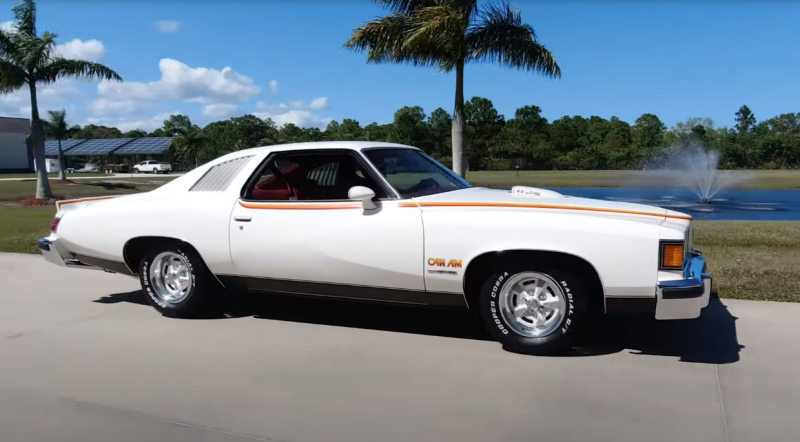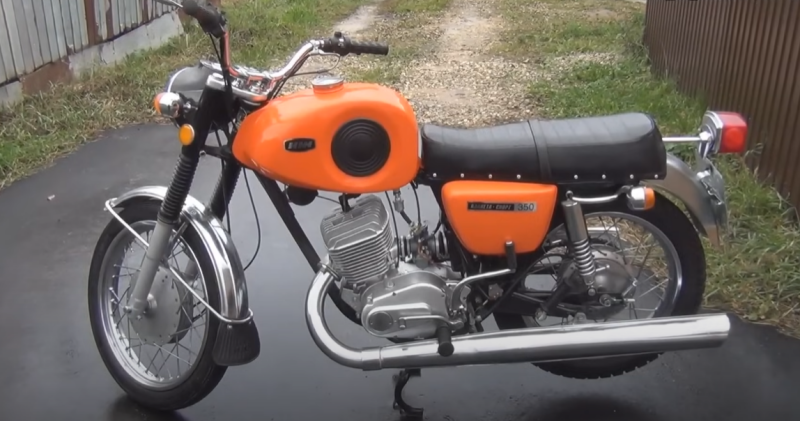We will find out later into whose hands the scissors fell, who “cut” the fate of the magnificent model. In the meantime, about the era, trends, trends, fashion. So we get to the car on which a lot has come together.
Typical "American"
Phenomena, concepts, terms associated with the 1977 Pontiac LeMans Can Am coupe are purely American. Let's figure it out: was hot rodding widespread outside the United States? A little in Canada, Australia, and a number of other countries. But not en masse, not with the same enthusiasm and scope as in the States. Hot rod is a local American phenomenon. This is what historians of the engineering industry and car fashion experts think.
 Pontiac LeMans Can Am 1977, created during the "Sick Era". Photo: YouTube.com
Pontiac LeMans Can Am 1977, created during the "Sick Era". Photo: YouTube.comLet's continue: did Europe produce muscle cars? Some semblance, and not for long, so we can say no. And finally: was the oil crisis of the 70s called the “Sick Era” in the Old World? The term was coined by the 39th US President Jimmy Carter. So the answer is no.
It turns out that the strong, uniquely beautiful Pontiac Le Mans Can Am car is a typical “American”. A worthy representative of the inimitable overseas style. The model also had another fate - to become the last real “muscle guy”.
Although Ford will show off its “last”, Chrysler will also have its final model. And our hero is “Dzhiemovsky”. Let us remind you: the Pontiac company, founded in 1899, has been owned by the powerful General Motors corporation since 1926. In 2010, the Pontiac division was abolished, which broke the hearts of brand fans around the world. Isn't this another reason to remember the coupe?
Hot rodding and muscle cars
It is impossible to ignore these things if we want to understand the reasons and circumstances of the birth of the model. The hot rod subculture originated in the pre-war 30s and 40s of the last century.
 Pontiac LeMans Can Am 1977 hood with triangular stamping and shaker hole. Photo: YouTube.com
Pontiac LeMans Can Am 1977 hood with triangular stamping and shaker hole. Photo: YouTube.comThe situation was like this: cars with mad horses under the hood cost a tidy sum and belonged to respectable men. Such citizens do not strive to overcome the 200-kilometer mark on the speedometer.
And young people, who, due to their age, could not buy expensive, fast and powerful cars, conjured roadsters in garages. The latter were affordable for young people, or they were inherited from their parents. Tuners strengthened the suspension, modernized the engines, and installed huge rear wheels.
Then the “crazy” youths with a small amount of intoxicating substance in their blood and a complete lack of sense of self-preservation squeezed the impossible out of the units. At street races, modified “shells” often flew the cherished quarter mile without attachments, with naked engines, or even without bodies at all.
Young people had a blast in cheap, old cars, but with souped-up units. In the 50s, the manufacturer noticed a huge layer of potential buyers and met them halfway. Leading machine manufacturers began to create mid-size sports cars with multi-liter engines. V8, of course. Ineffective, to tell the truth, but coveted “eights” with a V-shaped architecture.
 This is what muscle cars were like in the mid-60s. Photo: YouTube.com
This is what muscle cars were like in the mid-60s. Photo: YouTube.comCars were built in the American style to be long, heavy and power-hungry. The appearance was given a lean, swift, aggressive look. The price of the devices was suitable for young people who had not yet thoroughly found their feet.
Economic crisis
The heyday of models with specific features occurred in the years 1965-1975. But the oil crisis of 1973 broke out. Gasoline prices have quadrupled: from $3 to $12 per barrel. Spending 16-22 liters of fuel per 100 km of travel, as people have discovered, is expensive. The word “economical” is no longer a dirty word.
And then advocates for the environment and reducing emissions standards raised their heads. The voices of those fighting for the efficient use of engines, the reduction of accidents, etc. grew stronger. Muscle cars with their power did not fit into the changed standards.
 Pontiac LeMans Can Am 1977 is king on public roads. Photo: YouTube.com
Pontiac LeMans Can Am 1977 is king on public roads. Photo: YouTube.comIntelligent motorists have suddenly lost interest in “muscles”, theatrical races with roars and smoke from under the wheels. Somehow everyone suddenly became practical and sensible. And muscle cars, courageous handsome men, were left to fight in agony.
The decline of the Muscle car era
So, in the mid-70s, American muscle was decrepit. Other manufacturers hastily looked for a way out in modernizing engines and reducing fuel consumption. But not Pontiac. He rode the wave of success of previous cars and intended to maintain a sporty image.
Some models came off the assembly lines of major players in the car market. But there remained less muscle in sports-oriented cars than, as they now say, show-off. The bodies sported kitschy decor.
 "Pontiac Le Mans Can Am" at the exhibition. Photo: YouTube.com
"Pontiac Le Mans Can Am" at the exhibition. Photo: YouTube.comMore often these were vinyl stickers that said: the carrier, they say, is a Muscle car. This short period in the history of American engineering was even called the “era of stickers.”
The birth of the Pontiac LeMans Can Am 1977
Jim Wangers was a top manager at Pontiac. The managerial competence and professional skills of this employee were excellent. With his participation, in 1963 the company created the first muscle car, the Pontiac GTO.
Wangers did not want to realize that the “muscle guys” were destined for a place of honor in the closet of history. I didn’t believe that the fans fell for the despicable savings. The manager suggested that CEO Alex Mair return to the roots and create a muscular model according to the classical canons.
 Pontiac LeMans Can Am 1977: owners cherish rare cars. Photo: YouTube.com
Pontiac LeMans Can Am 1977: owners cherish rare cars. Photo: YouTube.comAmong his compatriots, there will be at least 2 fans who remember strong cars and know a lot about the power of engines, Wangers convinced the manager. A. Meir gave the marketing genius the go-ahead. We settled on the fact that the limited series will only be published for one year. The year 500 came into force.
Scissors and Hawaiian shirt
The model was based on the Le Mans production model, named after the popular auto racing. The exterior and interior were commissioned to be developed by the company's chief designer, Joe Schinella. The name was going to be “ALL AMERICAN”. All-American, that is.
When the vinyl stickers with the name lay on the table of the model’s ideological inspirer, Jim Wangers, he carefully looked at the long inscription. Then I took scissors and cut out 2 syllables: “AM” and “CAN”. The remaining letters went into the trash bin. The syllables have been rearranged. Not thoughtlessly: this was the designation of the popular Canadian-American racing series of the US motorsports club.
 The famous “ducktail” Pontiac LeMans Can Am 1977. Photo: YouTube.com
The famous “ducktail” Pontiac LeMans Can Am 1977. Photo: YouTube.comWe decided on a name: capacious, compact, beautiful. What to do with the color scheme? Without a twinge of conscience they decided to flirt with the user. The country was going to celebrate the 200th anniversary of education, it would be a sin not to play on the patriotic feelings of fellow citizens. The color of the 2-door was chosen to be white and added brown, yellow and orange - the tones of a traditional Hawaiian shirt.
Car review
The technological process was built in a unique way: the cars were manufactured at the Pontiac plant, and the decor was entrusted to the Detroit company Motortown Corporation. The certified organization undertook to sculpt those same stickers on the hulls and install a neat spoiler on the rear deck. The element was called "duck tail".
 1977 Pontiac LeMans Can Am interior in Hawaiian shirt style. Photo: YouTube.com
1977 Pontiac LeMans Can Am interior in Hawaiian shirt style. Photo: YouTube.comThings moved quickly: in January the model was presented to the public at the NAIAS auto show, and a couple of months later the production lines started working. Dealers placed orders for 5 thousand copies.
Exterior, interior
The cars took off. Buyers liked the Can Am: its original rear, sports mirrors, light tinting on the windows, and a glass or metal sunroof. Massive bumpers gave confidence, and dual rectangular optics gave beauty.
Weight and size indicators of "Can Am":
✅ Length - 5283 mm
✅ Width - 1966 mm
✅ Height - 1354 mm
✅ Weight - 1760 kg
The car stood on 15-inch wheels with cool aluminum rims of the “Rally 2” type. Radial tires GR70-15. Between the axles there was 2845 millimeters, providing interior space in the 4-seater coupe.
On the front hood, with its elegant wedge-shaped stamping, there was a highlight of the model - a shaker cutout. This is the so-called shaking scoop, which was an air intake installed in the engine compartment directly on the engine air cleaner. “Shaker” - because it vibrates with the engine. The part increased the performance of the power unit.
 Pontiac Can Am dashboard. Photo: YouTube.com
Pontiac Can Am dashboard. Photo: YouTube.comThe salon greeted us with coziness and comfort. The dashboard is richly decorated with wood. The Strato's Hawaiian shirt leather bucket seats were comfortable. The seat belts were the same color as the car seats. Travelers were provided with a radio, electric windows, and air conditioning. There was also a central lock.
Motors, chassis
As the creators intended, the car was high-tech. Take, for example, anti-roll bars on both axles. The structure was built on a ladder frame. The engine is located longitudinally in front. Torque went to the rear drive wheels through a THM-3 350-speed transmission.
Characteristics of the V8 configuration power plant:
✅ Volume – 6,6 l, as evidenced by the sticker on the shaker
✅ Power - 200 liters. With. at 4,0 thousand rpm
✅ Moment of force - 441 N * m at 2,4 thousand rpm
Performance indicators were impressive with a maximum speed of 190 km/h and acceleration dynamics of 0-96 km in 8,6 seconds. That is, the car flexed its muscles both outside and under the hood.
 1977 Pontiac LeMans Can Am engine bay with shaker scoop. Photo: YouTube.com
1977 Pontiac LeMans Can Am engine bay with shaker scoop. Photo: YouTube.comRoad bumps were dampened by front independent and rear dependent suspension. Both are on springs. The brakes were controlled by reinforced disc mechanisms at the front and hydraulic drums on the rear axle.
Circulation
It turned out to be an embarrassment, a tripping while running. The brisk sales stopped due to unforeseen circumstances: the press that produced duck tail spoilers broke down. The company responsible for styling the coupe, Motortown Corporation, asked for 3 months to fix it. In the meantime, they say, sell cars without “tails”.
Pontiac did not want to lose face in front of users and, having calculated the upcoming losses, discontinued the model. There are two figures for the number of vehicles produced: 1133 and 1377 units. We lean towards the latter, coming from Jim Wangers. Needless to say, a car with “rarity” status has become a hotly desired object for collectors?..










